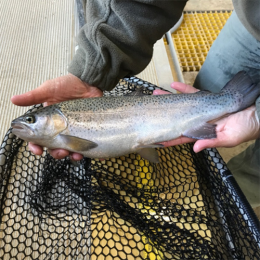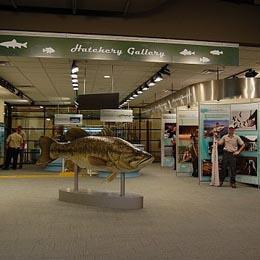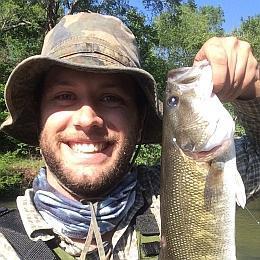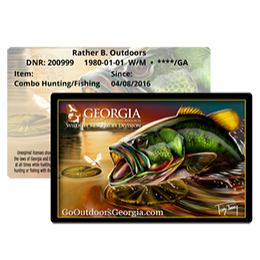
By Terry W. Johnson
Would you believe me if I said you could help preserve and enhance our native plant and animal heritage as well as the environmental health of Georgia without ever leaving your home? Probably not.
If I went on to say you could do this by encouraging caterpillars in your yard, you would probably be convinced I was out of my mind. In truth, however, my statements are not as far-fetched as they may sound.
We all realize we have left a large footprint on our nation's landscape. Many of the changes brought about at the hands of man have changed the complexion of our country and have had a deleterious impact on the wild plants and animals with which we share the land.
When James Oglethorpe sailed into the mouth of the Savannah River looking for a site to establish a new colony in 1733, more than 3,600 species of native plants blanketed the land in what has since become the state of Georgia. Despite the amazing array of native plants growing here, like other colonists that had already arrived in the New World, it didn't take the first residents of Savannah long to begin introducing a wide variety of exotics. These plants were brought here principally to provide food, feed for livestock or landscaping for the settlers’ homes.
Other non-native species were hitchhikers, and unintentionally brought here from foreign lands.
Literally hundreds of hundreds of exotic plants were brought to the New World beginning in the 1600s. It is believed the dandelion was brought to the Plymouth Colony by the Pilgrims in 1620. Mimosa arrived in 1745. Kudzu landed on our shores in 1876. And the foreign plant invasion continues to this day.
Some plants, like Japanese honeysuckle and Chinese privet, have proved highly invasive. Other foreign ornamentals such as azaleas and roses have become some of our most beloved plants. In fact, the planting of ornamentals around our homes and elsewhere has become so widespread that in most yards, foreign plants far and away outnumber natives.
In the meantime, as the human population continues to grow, each year wildlife habitat is either lost or significantly altered. It is estimated nationwide that about 2 million acres—an area roughly the size of Yellowstone National Park—is converted each year to urban/suburban habitat alone.
The staggering realization is that 54 percent of lands that were once wild in the 48 contiguous states have been transformed into suburban/urban habitat, our fastest growing habitat type and where most Americans currently live.
It is widely accepted that habitat loss has played the most significant role in declining wildlife populations across our country. However, according to Dr. Douglas Tallamy, professor and chair of the Department of Entomology and Wildlife Ecology at the University of Delaware, all the while we were destroying or modifying our lands, unknown to most of us we were also radically damaging the food chains through the proliferation of exotic plants. The reason why is that the non-native plants dominating our yards, neighborhoods and communities are usually of little if any food value to native wildlife. With little or no suitable food, countless ecosystems have been seriously compromised. This is particularly true in urban/suburban settings.
Tallamy strongly believes there a direct correlation between the increased use of foreign ornamental plants and a decline in native animals.
Insects are key players in modern day food chains. They are the animals that funnel energy captured by plants from sunlight to a myriad of those animals that do not eat plants. This is critical to the wildlife that we are most familiar with such as birds, frogs, toads, salamanders, praying mantises and others.
Insects are particularly important to birds. Ninety-six percent of all land birds eat insects at some time during their lives.
According to Tallamy, caterpillars are the most important insects to birds and other animals. Caterpillars are the larval form for moths and butterflies, gossamer-winged insects that make up more than 50 percent of the herbivorous insects in the country.
In Georgia, there are 174 species of butterflies and from 1,000 to perhaps 1800 or more species of moths. New species of moths are discovered each year. Many of these moths and butterflies live in your backyard.
Most homeowners are able to attract 30 or more species of butterflies to their yards. At the same time, some backyards are home to more than 100 species of moths. A research technician working for the University of Georgia's Research and Education Garden documented more than 170 species of moths drawn to the porch lights of her home in Griffin. I have identified 50-plus species in my Monroe County backyard.
Even birds you might never think about eating insects depend on caterpillars. For example, when we think of a Carolina chickadee, what often comes to mind is the image of it plucking sunflower seeds from a feeder and flying off to a nearby branch. There, after positioning the seed between its feet, it chisels the seed hull open and devours the fat-rich sunflower meat.
While Carolina chickadees do eat a lot of seeds, they raise their young almost entirely on caterpillars. During the 16-18 days it takes for chickadees to fledge, a pair of adults will feed their voracious young anywhere from 6,000 to more than 10,000 caterpillars.
Even the eastern bluebird feeds its young caterpillars. Studies have shown that a pair of bluebirds feeds their young 300 caterpillars a day.
The yellow-billed cuckoo, sometimes referred to as the rain crow, has an insatiable appetite for tent caterpillars. They have been known to descend on a tent caterpillar nest and gobble up 100 or more caterpillars before flying off in search of more food.
Noted ornithologist and writer Dr. Scott Shalaway estimates that songbirds may consume 1 million caterpillars a day in a 640-acre hardwood forest studied in Ohio.
The problem is that in our backyards and communities, native plants have become more difficult to come by. They have been replaced by a long list of foreign introductions. These plants, such as crepe myrtle, simply do not support as many different kinds or numbers of caterpillars and other insects that thrive on native vegetation.
Butterflies and moths will only lay their eggs on certain plants called host plants. Some species have only one host. For example, the host plant for the zebra swallowtail butterfly is pawpaw.
Studies conducted by Tallamy and his colleagues have demonstrated that 35 times more caterpillar biomass can be found on native woody plants than on exotics. In addition, those insects that do feed on exotics are often not eaten to any great extent by native wildlife. As if that is not enough, Tallamy found that native ornamental plants support far more biodiversity (29 times more) than exotic plants.
Here are a few of the most valuable butterfly and moth host plants that will grow in Georgia backyards. By far, the oaks play host more butterfly and moths than any of our trees. Would you believe that oaks are host for 557 species of moths and butterflies? Hickories support 235 species and native dogwoods 116.
It is clear that if we want to have a diverse natural community populated with butterflies, moths, birds and other critters, we need to find places in our home landscapes for native plants. Our reluctance to bring native plants home is often based on the belief that they are not attractive, and that they’re difficult to grow and maintain. Yet nothing could be further from the truth. They are often more disease resistant than exotics and require less fertilizer, less water and less care.
As for beauty, nothing can compare to the beauty of many of our Georgia native plants. Two notable examples are our native azaleas and the fringe tree. In addition to displaying breathtaking beauty, their blossoms have a pleasing aroma. In the case of the fringe tree, it bears olive-like berries that birds and other wildlife eat.
Nobody is suggesting that we replace our cherished Asian azaleas, prize roses or beds full of a kaleidoscope of ornamental flowers. Instead, we are being asked to add native plants to our home landscapes.
Tallamy's research has shown that the yards with the greatest variety of native plants attract the most diverse animal populations. However, even small increases in the native plant populations in yards have been found to make a difference.
Keep in mind that with each native ornamental planted, we are helping restore native animal and plant populations that otherwise would be lost in our neck of the woods. This, in turn, will begin repairing natural food chains. Every yard populated with exotics makes a difference. Lots of such yards will make a huge difference, in our well-being and the environment’s health.
Who would have ever thought that caterpillars are so important to the wellbeing of our wild neighbors, and of us?
DNR and The Garden Club of Georgia are adding a component to their Community Wildlife Project called Gardening with Native Plants. The application includes a list of 100 native plants that provide food for wildlife, and encourages homeowners to plant more native plants on their property. The Garden Club’s website will soon include a program application that can be downloaded. Check for it by clicking GCG Forms and scroll down to the Community Wildlife Project links.
Terry W. Johnson is a retired Nongame program manager with the Wildlife Resources Division and executive director of The Environmental Resources Network, or TERN, friends group of the division’s Nongame Conservation Section. (Permission is required to reprint this column.) Learn more about TERN, see previous “Out My Backdoor” columns, read Terry’s Backyard Wildlife Connection blog and check out his latest book, “A Journey of Discovery: Monroe County Outdoors.”
 An official website of the State of Georgia.
An official website of the State of Georgia.




